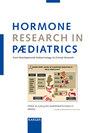输血依赖型 地中海贫血症青少年女性的卵巢功能不全;垂体与卵巢铁过载。
IF 2.6
3区 医学
Q3 ENDOCRINOLOGY & METABOLISM
引用次数: 0
摘要
导言:输血依赖型 地中海贫血症(TDT)女性患者即使螯合良好,在一生中的某些阶段也会出现月经不调和不孕症,这给她们的身体和心理造成了极大的负担。人们对垂体和卵巢铁含量对卵巢储备和功能的影响知之甚少。因此,本研究旨在评估患有 TDT 的青少年女性的卵巢储备功能和垂体-性腺轴功能,并将其与垂体和卵巢体积、垂体铁负荷和血清铁蛋白相关联。对TDT诊断年龄、输血指数、螯合疗法类型、初潮年龄和坦纳乳房分期进行了评估。对血清卵泡刺激素(FSH)、黄体生成素(LH)、抗穆勒氏管激素(AMH)和铁蛋白水平进行了测量。磁共振成像(MRI)用于测量垂体铁含量 R2* 和 T2*,并进行了三维经腹卵巢超声波检查。20名患者(40%)发现卵巢功能不全。与对照组相比,患有 TDT 的青春期女性的初潮年龄、AMH、FSH、LH、前卵泡计数(AFC)和卵巢体积明显推迟。在对有卵巢功能不全和无卵巢功能不全的青少年进行比较时,有卵巢功能不全的TDT青少年的血清铁蛋白和垂体MRI-R2*值明显高于无卵巢功能不全的青少年。多变量逻辑回归显示,垂体 MRI-R2* 是与 TDT 青少年女性卵巢功能不全相关的最重要的独立变量。因此,在对患有 TDT 的女性进行内分泌随访时,应定期进行卵巢储备功能评估,并建议对可能存在卵巢功能不全的女性采取保留生育能力的措施。本文章由计算机程序翻译,如有差异,请以英文原文为准。
Ovarian Insufficiency in Adolescent Females with Transfusion Dependent -thalassemia; Pituitary Versus Ovarian Iron Overload.
INTRODUCTION
Females with transfusion-dependent -thalassemia (TDT) display menstrual irregularities and subfertility at certain points in their lives, even if well chelated, representing a significant physical and psychological burden. Little is known about the effects of pituitary and ovarian iron contents on ovarian reserve and function. Hence, this study aimed to assess ovarian reserve and pituitary-gonadal axis function in adolescent females with TDT and correlate them with pituitary and ovarian volume, pituitary iron load, and serum ferritin.
METHODS
Fifty adolescent females with TDTs were compared with 50 age-matched healthy females. Age at diagnosis of TDT, transfusion index, type of chelation therapy, age at menarche, and Tanner breast stage were assessed. Serum follicle-stimulating hormone (FSH), luteinizing hormone (LH), anti-Müllerian hormone (AMH), and ferritin levels were measured. Magnetic resonance imaging (MRI) was used to measure the pituitary iron content R2* and T2*, and 3-D transabdominal ovarian ultrasound was performed.
RESULTS
The mean age of the studied females with TDT was 14.54 ± 2.24 years. Ovarian insufficiency was found in 20 patients (40%). Compared with controls, adolescent females with TDT had a significantly delayed age of menarche, AMH, FSH, LH, antral follicle count (AFC), and ovarian volume. In a comparison of those with and without ovarian insufficiency, adolescents with TDT with ovarian insufficiency had significantly higher serum ferritin and pituitary MRI-R2* values than did those without insufficiency. Multivariate logistic regression revealed that pituitary MRI-R2* was the most significant independent variable associated with ovarian insufficiency among adolescent females with TDT.
CONCLUSION
Adolescent females with TDT have decreased ovarian reserves, AFCs and gonadotropins, which are correlated with the serum ferritin level, pituitary iron load and ovarian volume. Hence, regular ovarian reserve assessment should be implemented as a part of the endocrinological follow-up of females with TDT-advising procedures to preserve fertility to those who are likely to have ovarian insufficiency.
求助全文
通过发布文献求助,成功后即可免费获取论文全文。
去求助
来源期刊

Hormone Research in Paediatrics
ENDOCRINOLOGY & METABOLISM-PEDIATRICS
CiteScore
4.90
自引率
6.20%
发文量
88
审稿时长
4-8 weeks
期刊介绍:
The mission of ''Hormone Research in Paediatrics'' is to improve the care of children with endocrine disorders by promoting basic and clinical knowledge. The journal facilitates the dissemination of information through original papers, mini reviews, clinical guidelines and papers on novel insights from clinical practice. Periodic editorials from outstanding paediatric endocrinologists address the main published novelties by critically reviewing the major strengths and weaknesses of the studies.
 求助内容:
求助内容: 应助结果提醒方式:
应助结果提醒方式:


